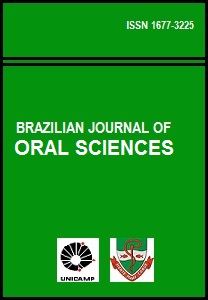Abstract
The aim of this research was to compare three methods to evaluate the availability of existent space in the mandible posterior segment; the methods are the Merrifield’s (1986), Ricketts’ (1976) and Richardson’s (1992). Sixty 60 teleradiographs in lateral pattern, from head, belonging to 60 Brazilian leucoderm subjects were evaluated. The age range from 9 to 19 years, all having a mal-occlusion of Class II, division 1, equally separated as for the gender (being 30 of male gender and 30 of female gender). It was concluded: Evidence of growing in the mandible arch posterior segment in the age range studied, with mean values of 10,21 mm for the Merrifield, 11,21 mm for the Richardson and 17,84 mm for the Ricketts methods. We have concluded that irrespective of the evaluated method, it was verified that the female gender has a more precocious growing (12,17 mm) as compared to the male gender (8,81 mm), in the ages 9 to 12. In the correlation between the employed methods, there was no a statistical difference among themselves by the t test, in the level of 1% (p £ 0,01).References
Rothenberg GF. The lower third molar problem. Am J Orthod Oral Surg 1945; 31: 104-15.
Ricketts RM. A principle of racial growth of the mandible. Angle Orthod 1972; 42: 368-86.
Silling GBS. Development and eruption of the mandibular third molar and its responsive to orthodontic therapy. Angle Orthod 1973; 43: 271-8.
Morehouse HL. Third molar and their relation to orthodontic treatment. Int J Orthod 1980; 38: 911-21.
Toro F, Aravena H, Mayoral G. Evolución seguida por los terceros molares durante el tratamiento de ortodoncia. Rev Ibero-amer Orthod 1984; 4: 55-68.
Leyard Jr BC. Study of the mandibular third molar area. Am J Orthod 1953; 39: 366-73.
Hoek RB, Third Molars. J Am Dent Assoc 1964; 68: 541-8.
Richardson ME. Development of the lower third molar from 10 to 15 years. Angle Orthod 1973; 43: 191-3.
Merrifield L. Differential diagnosis guidelines. Tucson: The Charles H. Tweed International Foundation for Orthodontics Research; 1986, 7p.
Ricketts RM. Third molars enucleation: Diagnosis and technique. J Calif Dent Assoc 1976; 4: 52-7.
Richardson ME. Changes in lower third molar position in young adults. Am J Orthod 1992; 102: 320-7.
Merrifield L. Differential diagnosis with total space analysis. J CH Tweed Int fnd 1978; 6: 10-5.
Mitgard, J, Björk G, Linder-Aronson S. Reproducibility of cephalometric landmarks and errors of measurements of cephalometric cranial distances. Angle Orthod 1974; 44: 56-61.
Hellman M. Our third molar teeth, their eruption, presence and absence. Dent Cosmos 1936; 78: 75-762 15. Björk A, Jensen E, Palling M. Mandibular growth and third molar impaction. Acta Odont Scand 1956; 14: 235-72 16. Willis TA. The impacted mandibular molar. Angle Orthod 1966; 36: 165-8.
Kruger E, Thonson, WM, Konthasinghe P. Third molar outcomes from age 18 to 26: Findingas from a population-based New Zeland longitudinal study. Oral Surg Oral Med Oral Pathol Oral Radiol Endod 2001; 92: 150-5.
Harris JE. A cephalometric analysis fo mandibular growth rate. Am J Orthod 1962; 48: 161-74.
Bishara SE, Jamison JE, Peterson LC, DeKock WH. Longitudinal changes in standing heigth na mandibular parameters between the ages of 8 and 17 years. Am J Orthod 1981; 80: 115-35.
The Brazilian Journal of Oral Sciences uses the Creative Commons license (CC), thus preserving the integrity of the articles in an open access environment.

